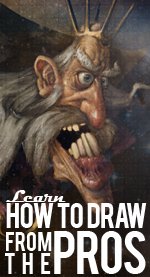Drawing Shading: Tips and TechniquesWhen drawing shading the most important thing is to understand about that it's all about pressure - the pressure of the pencil, the pressure of your hand, all the gradual and subtle pressure in between. Once you understand this, you'll be well on your way to mastering this technique.
Drawing shading is not about scribbling, but in the beginning it might be a good idea to run your pencil across the paper in a crazy, irrational way. So do it! Think of this as a warm up exercise. Once this mad dash to artistic fame is done, we will begin the drawing shading lessons. Throw away your eraser for now - you'll learn from your mistakes. Remember that there is no such thing as doing something 'wrong' in drawing. In the beginning, as I state in my personal drawing philosophy, it's best to think only in terms of practice and learning rather than trying to get ahead of yourself while trying to create a masterpiece. Use the time you have now to explore drawing from as many different angles as you can. Eventually you will find techniques that work best for you. Control of the Pencil To know when to press hard or ease up while pressing lightly, begin a series of lined diagonal movements across the paper, using 'up and down' strokes with your pencil - going from light to dark, or dark to light. You can also shade in a series of boxes, with different shades in each one. This will help you to become familiar with the range of values that you are able to produce with your pencil. As you practice, shading again and again with different techniques, you will eventually be able to do this effortlessly without a second thought.
Once you gain mastery over the strokes and values of drawing shading, the ability to know where the light is placed, and its reference to your forms or objects, will be your next step. Almost all drawings represent how the light is placed, by using shadows across the surface of the paper. If light is not used and the picture appears flat on the paper, it is considered a line drawing - the identification of an object by the use of a visible edge of a solid line. When you are drawing shading with light as your reference point, and using different tones, or values, do not use a strong line. Linear drawings and value drawings are "two entirely different types of drawings." Do not begin your drawings with line drawings, but with contour drawings, which are simply light outlines of the forms you are going to use - the shading will work them into the value drawings with the light shading and dark shading separating each item from another area. If realistic drawings are what you want to accomplish, do not mix them.
When working with perspective, use geometric contour drawings to represent how the objects appear on the paper. They will get smaller, larger or appear next to each other - as compared to close by, next to, and far away - to make them look 3 dimensional. The simplest method of making objects look 3-dimensional is single-point or one-point perspective. Items appear to be diminishing towards one single spot in the horizon ahead of them. Many artists use it as a visual trick, like interior views, fences, road and highways, buildings, etc., where the front sides are parallel to the picture plane, and the side edges recede to a single point. Don't Miss This - Learn to Draw from Professional ArtistsAre you looking to make a breakthrough with your artistic abilities? Artists from the world's top studios like Disney, Nickelodeon, Blue Sky, and Pixar are sharing their hard-earned knowledge so you can learn directly from the people who create the amazing comics, movies and cartoons that we all watch and love. If you're tired of looking for a good teacher - stop looking right now and click this link. For more great information on learning about shading hop over to how-to-draw-and-paint.com where there are lots of additional lessons for you to check out. |
 |